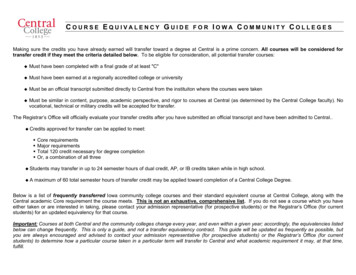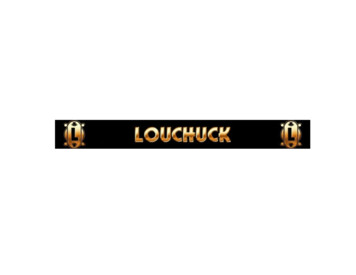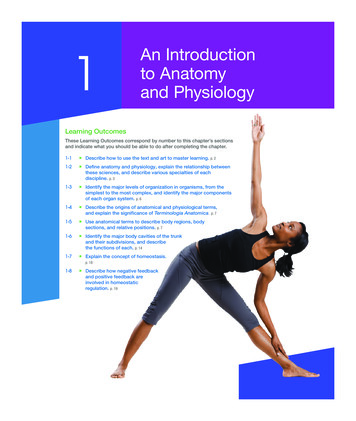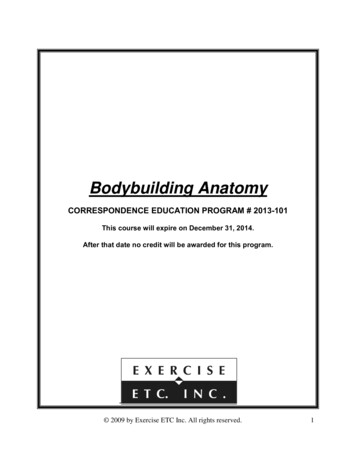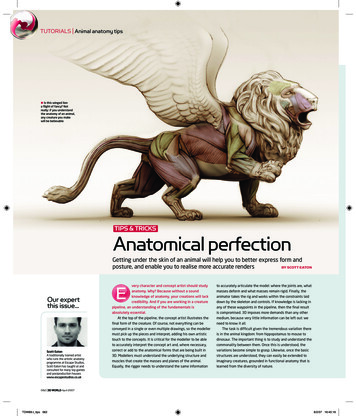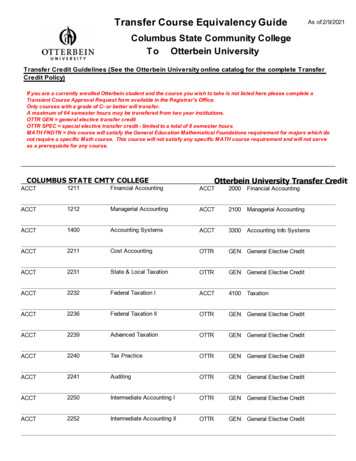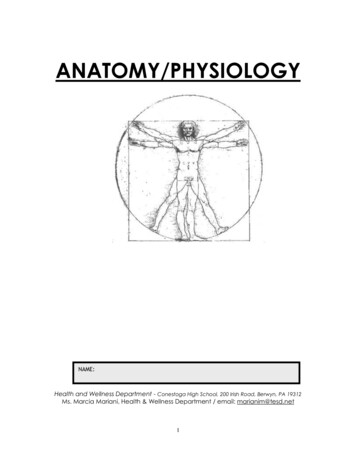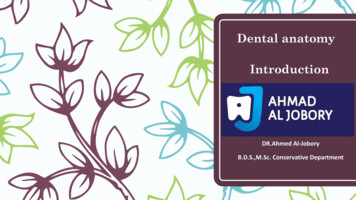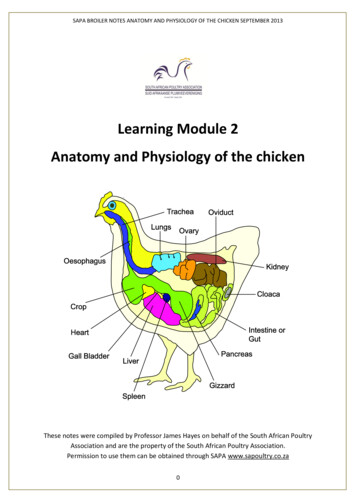
Transcription
SAPA BROILER NOTES ANATOMY AND PHYSIOLOGY OF THE CHICKEN SEPTEMBER 2013Learning Module 2Anatomy and Physiology of the chickenThese notes were compiled by Professor James Hayes on behalf of the South African PoultryAssociation and are the property of the South African Poultry Association.Permission to use them can be obtained through SAPA www.sapoultry.co.za0
SAPA BROILER NOTES ANATOMY AND PHYSIOLOGY OF THE CHICKEN SEPTEMBER 2013ContentsAnatomy and physiology of the chicken Introduction The external body parts The skin: Two functions, protection and regulation of body temperature The skeleton of the bird The internal organs of the chicken The digestive tract: A critical link from feed to growth The functions of the different parts of the digestive system Mouth and crop Glandular stomach (or proventriculus) Muscular stomach (or gizzard) Small intestine and enzyme action Gall bladder (galblaas) Caeca and colon The cloaca The urinary system of the chicken (the kidneys) Respiratory system (lungs and air sacks) The blood circulation system The brain and nervous system The immune system of the chicken Reproductive system of poultry The male reproductive system The female reproductive system1
SAPA BROILER NOTES ANATOMY AND PHYSIOLOGY OF THE CHICKEN SEPTEMBER 2013Anatomy and Physiology of the ChickenNote to the learnerThe word anatomy means structure of the body and the organs in the body of the chicken.Physiology has more to do with the functioning of organs of the body, for example the digestion ofand absorption of feed. This knowledge is essential not only to enjoy your work more but also toempower you to be in a better position to identify problems and to provide conditions for goodproduction results.The external body partsThe external organs include the skin, eyes, ears, nostrils, comb and wattles and will be discussedfirst before proceeding to internal organs such as the digestive tract, reproductive system etc.Cells are the real working units of the body and all tissue consist of cells:Cells of muscle tissue are able to contract (shorten itself) to cause movement of the legs, wings etc.Liver cells make (produce) substances for the egg yolk. Cells lining the mouth cavity secrete saliva(moisture) to enable the bird to swallow feed. Skin cells consist of several layers of which the outerlayer is tough and dry and protects the body. The cells in bone are filled with calcium andphosphorus to make bones strong to carry the weight of the bird.Important knowledge:The tissue of all organs consists of cells that enable that organ to perform its function. In youngchickens growth is the duplication of cells of the various organs. Cells receive nutrients from feed bymeans of the blood stream for their duplication. The chemical reactions taking place inside cellsresult in heat being produced. This is the origin of the warmth of a living animal.Poultry have good eye-sight: detect colour; prefer green andyellow. Shiny objects such as water droplets on a nipple lineattract attention of young chickens.Can smell and will detect offensive smells. Will try to avoidareas where ammonia is in the air e.g. wet spots underdrinker lines.Can hear very well. Noises such as banging of trolleys orcrates and people shouting, cause stress and affect immunedevelopment after vaccination.The comb and wattles are well supplied with blood vessels.Cool air moving over these areas removes body heat. Theseorgans thus assist with body temperature regulation in hotweather.2Eye and eyelidsCombEarBeakOpening of noseWattles
SAPA BROILER NOTES ANATOMY AND PHYSIOLOGY OF THE CHICKEN SEPTEMBER 2013The skin: Two functions, protection and regulation of body temperatureUpper, horny layer of skinMiddle layer,The cells here produce the upper layerInner layer contains blood vessels.Feathers are formed in this layerProtective function:The outer horny layer has no blood supply, scratches through this layer will not result in infectionbut into the deeper layers infections will occur. Feathers growing from the skin have an insulatingeffect and protect the bird from losing heat to the environment during cold conditions.The day-old chicken hatches with afluffy hair-like structure called down.It has very little insulating value and thechick will lose body heat attemperatures of 25 C.The down is replaced with feathersformed by cells in the skin follicles.Feathers are replaced several timesbefore adult feathers have formed.Left: Down in day-old chicken.Centre: Arrow showing growth of feather follicle pushing down out.Right: Mature feather.The function of the skin is to protect the bird from losing moisture to the environment and also inthe regulation of body temperature. Poultry do not have sweat glands like humans or horses orcattle. During very hot weather they pantwith beaks open to lose moisture from themouth where cooling then takes place.Regulation of body temperature: The skin isvery well supplied by blood vessels, and thatcauses the skin to be warm.Cool air moving over the hot skin would thuscause cooling of the skin and cooling of theblood that flows back to the inner organs.It is often seen on hot days that the chickenswould raise their wings to allow airmovement over the skin.Important to realise cooling can only takeplace if the air temperature is cooler thanbody temperature of the bird.Figure 1 Blood vessels to and from the skin3Layer wvessels afeather
SAPA BROILER NOTES ANATOMY AND PHYSIOLOGY OF THE CHICKEN SEPTEMBER 2013The skeleton of the birdSkeleton of an adult chickenImportant knowledge:Bone cells consist mainly of the minerals calcium and phosphorus.The skeleton is a framework of bones to which muscles are attached.The skeleton provides rigidity (firmness) to the body.The skeleton provides protection to internal organs, for example the digestive tract, heart, lungs, kidneysand the reproductive system, etc.Contraction of muscles results in movement of those bones to which the muscles are attached. All kindsof movement are brought about by such contractions: walking, flapping of wings, movement of the neckand head to pick up feed or to drink.Also respiration where the body cavity is contracted or enlarged to expel air or to inhale air.4
SAPA BROILER NOTES ANATOMY AND PHYSIOLOGY OF THE CHICKEN SEPTEMBER 2013The internal organs of the chickenLook carefully at the position of the organs inside a hen as shown in the illustration depicted below.In this section we shall be studying the functions of the internal organs. This will not only be a veryinteresting exercise to know what happens to feed and water after it has been consumed, but youwill also enjoy to know more about the internal processes that take place in organs such as thelungs, the reproductive system and how body temperature is regulated. You will also learn moreabout those organs that are involved in protecting the chicken against diseases, the immune system.Cross-section through the body of a hen.5
SAPA BROILER NOTES ANATOMY AND PHYSIOLOGY OF THE CHICKEN SEPTEMBER 2013The digestive tract1:A critical link from feed to growthThe digestive tract has a most important role to digest feed and make nutrients available forutilization by cells to form and maintain all the different organs of the body. Important terminologylike digestion, absorption, transport of nutrients and heat production will also be explained. Beforeaddressing these aspects, please have a look at what are the basic components of a chicken’s body,in other words what must the diet supply to enable the chicken to grow, see the table below whichlists the composition of a chicken’s body.Composition of a chicken’s body?ConclusionThe basic (main) components of the chicken’s body are the following:Water.In a 100g chicken it amounts to65gFat.In a 100g chicken it amounts to15gMinerals.In 100 g chicken, (mainly calcium and4gphosphorus) amounts toProteins.In a 100g of chicken it amounts to16gWhen looking at a chicken, everything you see, whether from outside or in anopened bird, if the substance is not fat, minerals (as in bone tissue) or water (inblood or as wet tissue), then it is protein.Not only is dry, fat-free muscle pure protein, but also the feathers, toe-nails, dryfat-free liver, intestine, skin and many other dry, fat-free soft tissue.The main functions of the components mentioned in the above table are summarized inthe following table functions of the different components in the body of a chicken.Functions of the different components in the body of a chickenImportant anduseful knowledge1Water: All the many reactions inside body cells can only take place in water,Fat: It is a source of stored energy for the chicken.Minerals: Such as calcium and phosphorus are the main components in bonecells and make bones strong and rigid.Proteins: Are the chemical compounds of meat, feathers, toe-nails, the comb,wattles, intestines, the respiratory tract, etc. Everything that’s not fat, wateror minerals. Proteins in feedstuffs must first be digested to absorbablecomponents, called amino acids. Amino acids are then used by the cells of anorgan to form muscle cells, skin cells, liver cells etc. to enlarge, grow, organs.All processes where an action is performed, for example growth, movement,heart contraction etc require energy. This energy is obtained from glucose.Another term is the gastro-intestinal tract6
SAPA BROILER NOTES ANATOMY AND PHYSIOLOGY OF THE CHICKEN SEPTEMBER 2013Summary of the feed and growth process. In all body cells of the bird, energy from glucose, isconstantly being used to drive reactions that keep the body cells alive.Look carefully at Error! Reference source not found.Write down what you regard as growth and theconsituents necessary for growth of a chicken. You will see that the basic components and their ratiosare basically the same in a day-old chicken and the broiler at 35 days.NUTRIENTS FROM FEED WATER GROWTH OF THE BODYGrowth “Enlargement andMultiplication“ of tissues in the body dueto absorption of nutrients from feed andthe intake of water.Growth of the birdChemical substancesin the day-oldchicken, parts / 100gWater: 65Minerals: 4Proteins: 16ChemicalFat: 15Growth of the birdChemical substancesin the 35 day oldchicken, parts / 100gWater: 65Minerals: 4Proteins: 16Fat: 15Nutients from thefeed and watersubstancesin the day-oldchicken, parts / 100gWater: 65Minerals: 4Proteins: 16Fat: 15Nutients from thefeed and waterGrowth “Enlargement anMultiplication“ of tissues ito absorption of nutrientsthe intake of water.Chemical substancesin the 35 day oldchicken, parts / 100gWater: 65Minerals: 4Proteins: 16Fat: 15Feed contains:ProteinsMineralsFatsWater from drinker linesFeed contains:Summary of growth processesProteinsMineralsFatsWater from drinker lines7
SAPA BROILER NOTES ANATOMY AND PHYSIOLOGY OF THE CHICKEN SEPTEMBER 2013Test you knowledge memory challenge number 1CluesAcross46791011CluesDown12358Fluid secreted by cells in the mouth of the chickenOne of the main minerals in bone cellsThe type of reactions responsible for the warmth generated in the bodyThe feather-like structures with which the day-old chicken hatchesOne of the four components of the body that is not water, minerals or fatWord describing the structure of the bodyThe framework protecting inner organs of the birdThe working units in tissue of organsOne of the four components of the body that is not protein, water or fatThis substance serves as the source of energy for a chickenThese acids are the building blocks of proteinsNote to the learner.Memory challenge number 1 is based on information you have learned so far on poultry Anatomyand physiology. See how far you can get without referring to the notes. If you find that you are notable to complete the challenge a suggestion is to read through the notes again slowly and carefully.Should you find that you are unable to understand some of the concepts then you need to discussthese with your supervisor or facilitator.8
SAPA BROILER NOTES ANATOMY AND PHYSIOLOGY OF THE CHICKEN SEPTEMBER 2013The functions of the different parts of the digestive system.Mouth and cropImportant knowledgeDigestion is the process of making feed available for absorptioninto the body: Proteins in feed are digested to amino acids.Starch in feed is digested to glucose.Fat is digested to fatty acids.(Water and minerals are not digested but absorbed as such)Refreshing your mindThe feed is picked up and swallowed by means of the tongue. Salivary glands2 in the mouth secretemucus (slym) to enable passage of feed down the tract. (Read the footnotes indicated bysubscripts.)The chicken has taste buds on the tongue and can distinguish between different flavours. It preferssweet but will reject a bitter taste. Although taste does not play a very important role in the controlof feed intake by birds, they will reject feed that has become rancid3 or feed containing high levels ofsalt.The crop serves as storageorgan and no digestion takesplace there. However, it is inthe crop where feed is mixedwith water to soften feedparticles to enable thepenetration of acid4 whichimproves the digestionprocess, availability of wateris most important.SmallintestinePancreasFigure 2 Schematic illustration of the digestive tractMuscular stomach(or gizzard)23A gland consists of cells capable of producing and secreting products such as mucus (saliva, spit) in the mouth.Rancid means the fat has developed a bad smell during storage4Hydrochloric acid. (soutsuur) This is the acid also used in the water purification plant to adjust the pH of the drinking water.9
SAPA BROILER NOTES ANATOMY AND PHYSIOLOGY OF THE CHICKEN SEPTEMBER 2013Glandular stomach (or proventriculus)This is the first section of the gastrointestinal tract, see the diagram called the digestive tractof the chicken, where digestion really begins. (Digestion means breaking up into smallabsorbable portions). The cells lining the glandular stomach secrete enzymes that digestproteins to amino acids.Muscular stomach (or gizzard)The gizzard with its strong muscles and tough inner lining is very effective to grind toughparticles into a pulp on which enzymes can react very efficiently during the digestiveprocess.The digestive tract of the chickenSmall intestine and enzyme actionsIn the small intestine most by the wall of the small intestine into the blood stream and carried to thedifferent body parts where they fulfil their functions: amino acids to be formed into proteins glucoseand fats to be used as energy sources of the digestive reactions and the absorption of nutrients takeplace. The inner wall has finger-like structures that secrete (produce) a variety of enzymes that reactwith feed proteins, starch and fats to digest these components into their smallest units. Proteins toamino acids, starch to glucose and fats to fatty acids. These are absorbed by the wall of the smallintestine into the blood stream and carried to the different body parts where they fulfil theirfunctions: ammino acids to be formed into proteins, glucose and fats to be used as energy sources.10
SAPA BROILER NOTES ANATOMY AND PHYSIOLOGY OF THE CHICKEN SEPTEMBER 2013The pancreas.Keep in mind that the pancreas, the organ that lies in the loop of the small intestine, also plays amost important role in the production and secretion enzymes. These enzymes flow via a tube intothe small intestine where they also act on starch, proteins and fats in the feed to enable the bird todigest feed very efficiently. The only substance that cannot be digested is the fibre layersurrounding a mealie or wheat kernel.Household items: starch, glucose, protein and enzymesMaize meal and maize starch are very common itemsin most kitchens, maize starch5 or “Maizena” is afirming agent in gravy. In the intestinal tract of thechicken starch has to be broken down by enzymes toglucose before it can be absorbed and used as energysource by the tissue cells. Glucose is indeed also avery common item used in sports drinks such asGame.Protein in the household.Gelatine is a pure protein and dissolves in hot water. It is used for making jelly or puddings. It occurswith other proteins in tendons6, that tough, white tissue at the end of a muscle and is normally theattachment to the bone.Enzymes can be bought in pure form. On a bottle of meat tenderiser you will note in the list ofingredients it contains salt, a number of other substances, and proteolytic enzymes7. The client isadvised to allow 30 minutes after the meat tenderiser has been rubbed into the meat beforecooking or roasting the meat.The toughness in meat is caused by tendons. They are those white threadlike structures in themuscle that are connected to the bone, in other words they are part of the muscle. The chemicalreaction between the enzymes and those proteins of the tendon takes time to be broken down, thusthe reason for time to allowed for the reaction to take place.Gall bladder (galblaas)This sac-like organ is attached to the liver and can easily be recognised by it bluish-green colour. Gallis produced by the liver and the function is to break up fats and oil into very small droplets thatmixes with water. The reaction between enzymes and the fat can then take place to break it downinto fatty acidsCaeca and colonThe lower portion of the intestinal tract consists of the two caeca’s, and the colon, No absorption of5Starch is also the major component in products such as rice, potatoes, wheat and oats and there are indeed also many industrial usesfor starch in foodstuffs and in glues.6Tendons are described as connective tissue and consist of collagens, the collective name for a number of proteins in connective tissue.One of these proteins is gelatin and is extracted by an industrial process of filtration.7Proteolytic enzymes: chemicals that are able to digest proteins, break them up into their smallest building blocks11
SAPA BROILER NOTES ANATOMY AND PHYSIOLOGY OF THE CHICKEN SEPTEMBER 2013nutrients takes place here. Only water can be absorbed in the very lowest part of the colon, close tothe cloaca, and this saves the amount of water that a bird has to drink to transport indigestiblematerial through the gastro-intestinal tract.The cloacaThe cloaca, also known as the vent, serves as a temporary storage organ of the indigestible feedresidues and uric acid. In adult males the sperm ducts (tubes), or in females the tube (oviduct) inwhich the egg is formed, also have their openings in the cloaca.Digestion of feed and functions of the gastro-intestinal tractFeed swallowed and moves to cropCrop: Feed softened by waterIndigestible materialexcretedGlandular stomach: Digestion begins.Glands secrete acid and enzymesSmall intestineMuscular stomach: Grinding of hardparticles, digestion proceedsLoop of small intestine with pancreas.Feed proteins and starch digested byenzymes secreted by cells in intestinal walland by cells of the pancreas.Feed proteinsamino acidsglucoseFeed starchAbsorption of amino acidsand glucoseSummary of events after feed intake by the bird.12Digestion and absorptioncontinues
SAPA BROILER NOTES ANATOMY AND PHYSIOLOGY OF THE CHICKEN SEPTEMBER 2013Test you knowledge memory challenge number 2Clues CluesAcross Down1This is the source of energy used by cells and is the result of the digestion ofstarch2The acid secreted by the wall of the glandular stomach that assists with thedigestive process3Glands that secrete saliva4In that part of the digestive system feed is softened by water5Acids resulting from the digestion of proteins6The organ in the loop of the small intestine that produces enzymes for thedigestion of proteins, fats and starch.7This material cannot be digested by enzymes and excreted in the faeces8Produced by the liver to break fats up into small droplets to for enzymes to reactwith the fat.9The organ that grinds feed to increase surface areas on which enzymes can act todigest proteins, starch and fats in feed.10The last part of the gastro-intestinal tract where water that was contained infaecal matter, is absorbed.Note to the learner.Memory challenge number 2 is based on information you have learned since completing the lastmemory challenge. See how far you can get without referring to the notes. If you find that you arenot able to complete the challenge a suggestion is to read through the notes again slowly andcarefully. Should you find that you are unable to understand some of the concepts then you need todiscuss these with your supervisor or facilitator.13
SAPA BROILER NOTES ANATOMY AND PHYSIOLOGY OF THE CHICKEN SEPTEMBER 2013The urinary system of the chicken: the kidneys.In poultry the white topping on the faeces is the chicken’s urine. It consists of uric acid, a totallyinsoluble substance in water and is stored as a paste in the cloaca and excreted with the faeces.Importantknowledge.Uric acid is the waste product from chemical reactions inside body cellsand is passed into the blood stream.Function of the kidneys is to remove uric acid from the blood by meansof filtrationThe kidneys, see picture on the right, have the ability to separate uric acid particles from the bloodby means of a filtration process into the urinary tubes that run to the cloaca.During serious dehydration8 (read the footnote) uric acid crystals will block the tubes in the kidneys as wellas those running from the kidneys to the cloaca. Access to drinking water for chickens is of utmostimportance.The white uric acid crystals on thelivers and kidneys of day-old chickensthat suffered from dehydration, canbe identified during a post mortem.Feed containing exceptionally highlevels of salt due to mixing errors, willresult in birds consuming largequantities of water. Salt is soluble inwater (unlike uric acid!) and thekidneys excrete the salt as a waterysolution. (One should not bemistaken to see the situation asdiarrhoea because of the wateryappearance of the excreta.) In poultryhouses with wet bedding material,bacteria acts on uric acid and convertit to ammonia gas. Under dry conditions these reactions by the bacteria cannot take place.8Dehydration is when the bird has lost water from the body cells. This can happen during excessive panting in hot weatheror accidental water restriction for prolonged periods of time.14
SAPA BROILER NOTES ANATOMY AND PHYSIOLOGY OF THE CHICKEN SEPTEMBER 2013Respiratory system: lungs and air sacsImportantknowledge.Chemical reactions in body cells use oxygen9 to obtain energy fromglucose10 and carbon dioxide is produced during this combustion process.Oxygen is carried by the blood to body cells and exchanged for carbondioxide. In the lungs the carbon dioxide is given off to the inhaled air inexchange for oxygen.The extraction of oxygen from inhaled air is very efficient in poultry. The lungs are connected to anumber of air sacs in the body cavity, which enables the bird to extract oxygen twice from inhaledair, during inhalation and again when air leaves the body, in other words during exhalation.Diagram of the position of air sacs in the body. Right: Inflated air sac in abdominal cavity.During this combustion process of glucose, heat is generated and these reactions are the source ofheat that enables the body to maintain a temperature of 42 C. The fact that heat production is anon-going process (as long as the bird is alive), heat has to be given off constantly to air surroundingthe bird; this is to prevent the temperature of the bird from increasing. An important aspect withregard to the fact that poultry breathes air into air sacs of the body cavity, is the danger of inhalingbacteria such as E. coli that can cause an infection in areas close to the intestines, the liver andreproductive organs of the chicken. To have low dust levels in the air is thus a measure to try to limitbacterial infections of the air sacs. A picture with an E. coli infection in the body cavity that hasspread from the air sacs to the internal organs is shown in the following diagram.9Oxygen is only required as long as the animal is alive, when death sets in no more O2 is needed!Glucose can be regarded as the fuel for animal cells. In a car’s engine the petrol is combusted to obtain the energy lockedup in the petrol, oxygen is also required and carbon dioxide is produced. An almost similar situation in body cells exceptthat no real fire is produced but the chemical energy locked up in the glucose comes free with accompanying heat.1015
SAPA BROILER NOTES ANATOMY AND PHYSIOLOGY OF THE CHICKEN SEPTEMBER 2013Chicken with E. coli infection in the body cavity.16
SAPA BROILER NOTES ANATOMY AND PHYSIOLOGY OF THE CHICKEN SEPTEMBER 2013The blood circulation systemA simplified approach would be to view the blood system as a pipe-work of tubes, starting at theheart and branching off to enter and diffuse (getting smaller and smaller) into the tissue of organs.Inside the tissue they converge (come together again) to form veins that return the blood to theheart.Head andwing areasLungsRed indicatesoxygen rich bloodfrom the lungs fordelivery to bodytissues.Blue tubes containcarbon dioxidepicked up frombody tissue forcirculation to thelungs.In the feed:StarchProteinNutrients fromdigestive tractpasses throughliver on their wayto the heart.Illustration of a blood circulation systemThe functions of the blood circulation system are as follows, identify these from the sketch aboveshowing the blood circulation system and note the direction of blood flow by looking at the directionof the arrows:1. The heart pumps oxygen-containing blood (red blood vessels) to tissues of the various bodyparts where oxygen is given off and carbon dioxide picked up and blood returns to the heart.2. The carbon dioxide-containing blood (blue vessels) is pumped to the heart and lungs.Exchange of carbon dioxide for oxygen takes place and returns to the heart.3. Nutrients from digested feed is picked up in the digestive tract and transported to the liverand heart for distribution to body tissues.4. Transporting heat from inner organs to the skin. This is not illustrated in the illustrationabove but has already been discussed in an earlier chapter (If you are not sure, stop andread through the notes again). The rate of heat loss from the skin will obviously bedetermined by the difference in temperature of the body and the surrounding air.17
SAPA BROILER NOTES ANATOMY AND PHYSIOLOGY OF THE CHICKEN SEPTEMBER 2013The brain and nervous systemMessages are sent or received by the brain by means of a central nerve cord which branches toorgans such as the eyes, ears, muscles, etc. Nerves are thus almost like a network of power linesgoing to the different body parts or organs and will transmit impulses to the brain. The brain thenreacts depending on the type of the message.Loud noises for example will be perceived by the brain as danger and it would send a message to legand wing muscles to contract and to run or fly. In the case of hunger the message will be stimulatedby impulses created by low levels of glucose in the blood and the bird would go to the feeder line forfeed.External factors such as lighting patterns can also act as stimulus and be picked up by the eyes. Thebrain can indeed be stimulated to send messages to the reproductive organs of young pullets toform egg yolk or in male chickens to form sperm cells.Normal nerve on theleft and enlarged dueto disease on the right.Left: Nerve connected to muscle. Picture11 on the right: Two pieces of nerve strings.11Permission to use this and other pictures with the CEVA water mark was kindly granted by Prof. IvanDinev, Dept. of General & Clinical Pathology, Faculty of Veterinary Medicine, Trakia University, 6000 StaraZagora, Bulgaria. E-mail: idinev@uni-sz.bg.18
SAPA BROILER NOTES ANATOMY AND PHYSIOLOGY OF THE CHICKEN SEPTEMBER 2013Test your knowledge memory challenge number 3CluesAcrossCluesDown110235614789These tubes are blocked by uric acid in dehydrated chickensA network of these cords transmit messages to and from organs in the bodyThe organ responsible for blood circulationThis organ receive and send messages on signals from other organs in thebodyA gas that is essential for the combustion process of glucose inside body cellsAir is inhaled into these body cavities that are connected to the lungsProduct of chemical reactions inside cells and excreted by the kidneysA gas produced by bacteria in wet beddingDisease causing organisms that can be inhaled into the air sacsEnergy for the functioning of body cells is obtained from this substanceThe end products of feed digestion that are transported by the blood streamto body cellsNote to the learner.Memory challenge number 3 is based on information you have learned since completing the lastmemory challenge. See how far you can get without referring to the notes. If you find that you arenot able to complete the challenge a suggestion is to read through the notes again slowly andcarefully. Should you find that you are unable to understand some of the concepts then you need todiscuss these with your supervisor or facilitator.19
SAPA BROILER NOTES ANATOMY AND PHYSIOLOGY OF THE CHICKEN SEPTEMBER 2013Immune system of the chickenThe word immunity means to be protected. It therefor means that if a chicken is immune against aparticular disease it is protected against that disease. The immune system is able to produceantibodies that protect the chicken against the disease for which it was vaccinated. Poultry havespecific organs that are able to produce antibodies to protect them against a disease. This is thetopic of our discussion and after having studied this section, you will know where antibodies areformed and what their functions are.ImportantknowledgeAntibodies are chemical substances consisting of proteins.Specific organs make antibodies (for example bursa of Fabricius, thethymus glands, the bone marrow, the spleen, etc.).Antibody production is stimulated by applying a vaccine to the birds.Antibodies attach to a d
SAPA BROILER NOTES ANATOMY AND PHYSIOLOGY OF THE CHICKEN SEPTEMBER 2013 2 Anatomy and Physiology of the Chicken Note to the learner The word anatomy means structure of the body and the organs in the body of the chicken. Physiology has more to do with the functioning of organs of the body, for example the digestion of and absorption of feed.
